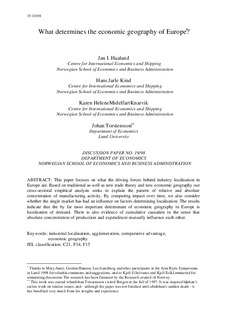| dc.contributor.author | Haaland, Jan Ingvald Meidell | |
| dc.contributor.author | Kind, Hans Jarle | |
| dc.contributor.author | Midelfart, Karen Helene | |
| dc.contributor.author | Torstensson, Johan | |
| dc.date.accessioned | 2006-09-06T06:46:45Z | |
| dc.date.available | 2006-09-06T06:46:45Z | |
| dc.date.issued | 1998-10 | |
| dc.identifier.issn | 0804-6824 | |
| dc.identifier.uri | http://hdl.handle.net/11250/163010 | |
| dc.description.abstract | This paper focuses on what the driving forces behind industry localisation in
Europe are. Based on traditional as well as new trade theory and new economic geography our
cross-sectoral empirical analysis seeks to explain the pattern of relative and absolute
concentration of manufacturing activity. By comparing impact over time, we also consider
whether the single market has had an influence on factors determining localisation. The results
indicate that the by far most important determinant of economic geography in Europe is
localisation of demand. There is also evidence of cumulative causation in the sense that absolute concentration of production and expenditure mutually influence each other. | en |
| dc.format.extent | 113964 bytes | |
| dc.format.mimetype | application/pdf | |
| dc.language.iso | eng | en |
| dc.publisher | Norwegian School of Economics and Business Administration. Department of Economics | en |
| dc.relation.ispartofseries | Discussion paper | en |
| dc.relation.ispartofseries | 1998:19 | en |
| dc.subject | industrial localisation | en |
| dc.subject | agglomeration | en |
| dc.subject | comparative advantage | en |
| dc.subject | economic geography | en |
| dc.title | What determines the economic geography of Europe? | en |
| dc.type | Working paper | en |
